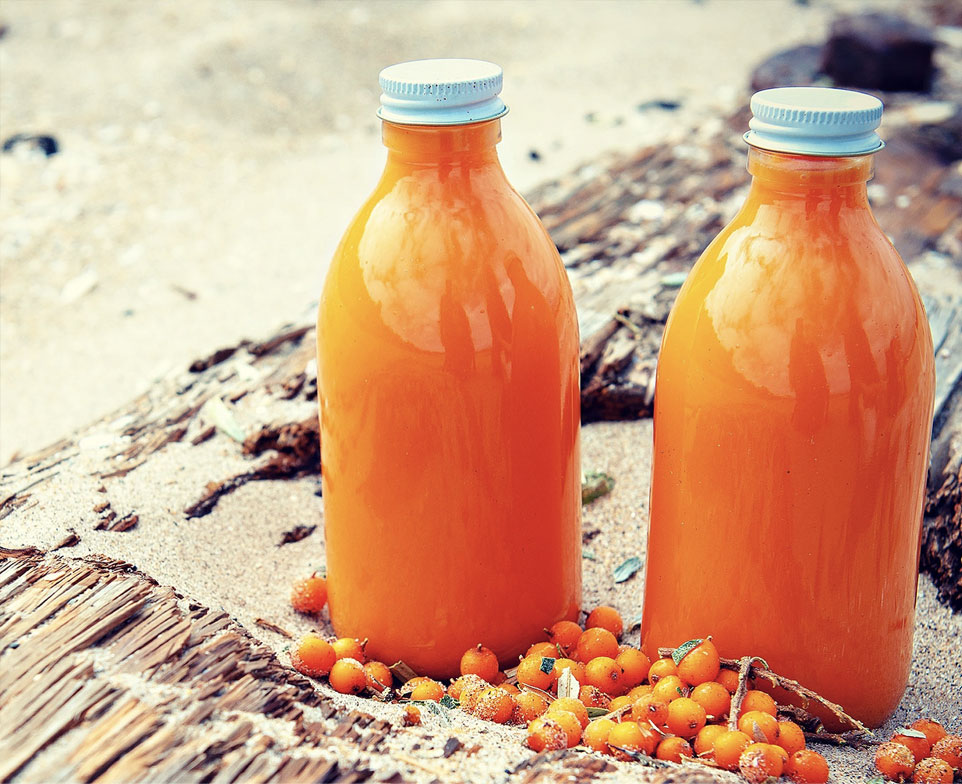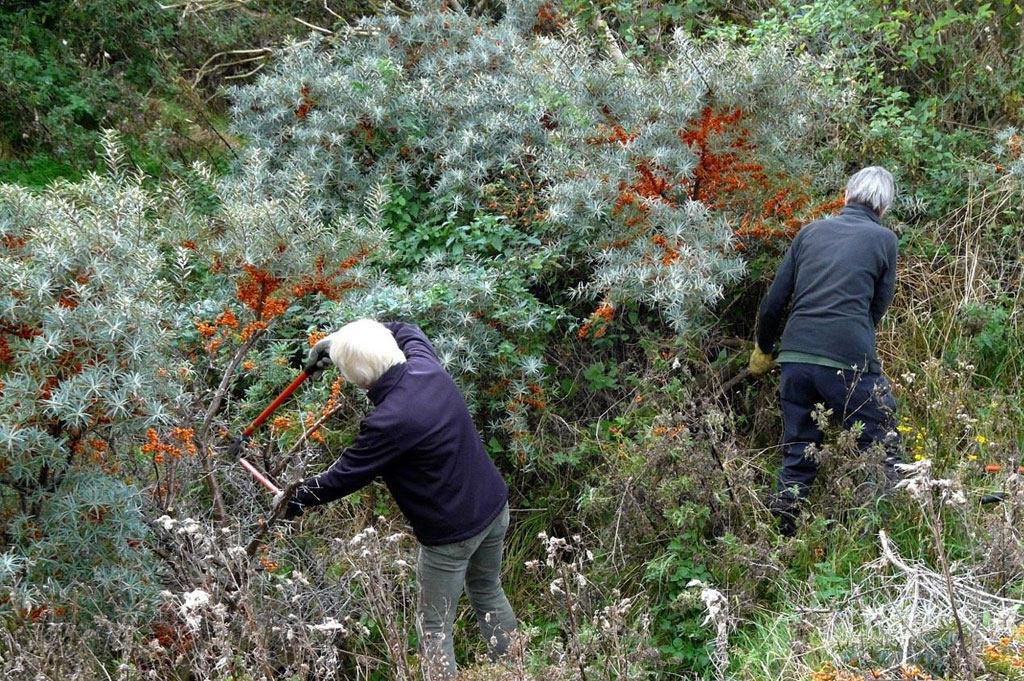Sea buckthorn is a spiny shrub that grows in sand dunes along the east coast of Scotland. It is a native plant but was also artificially planted in some areas to help stabilise dune systems, and is considered invasive in some parts of the country. Sea buckthorn is a large, deciduous shrub – growing to a height of 1-8m – that has long, narrow, greyish leaves and small, green flowers. Growing in dense thickets, it has dense and thorny branches and produces large volumes of bright orange berries in Autumn months.
Sea buckthorn is found along coastlines of Scotland, particularly along the east coast of the country. It is particularly abundant around the coast of East Lothian, where it is sometimes considered to be an invasive species. Large scale planting in this area was carried out in the 1960s to help stabilise the sand dunes – the growth would usually be controlled by grazing animals, particularly rabbits, but large outbreaks of myxomatosis caused a drop in rabbit populations which allowed the plant to flourish.
Sea buckthorn isn’t currently grown commercially in Scotland, but is instead collected and foraged from wild populations by individuals and small businesses. Further afield, the British Sea Buckthorn Company in England farms sea buckthorn on their farm in Essex, on the south coast of England.
Sea buckthorn berries have a long history of being used for their strong flavour, and medicinal and nutritional properties across the globe – it’s been recorded as being used in Tibetan medicine as early as the 8th century, and was used by Russian Cosmonauts on the first manned space mission thanks to it’s powerful antioxidant properties. But in Scotland we seem to have mostly overlooked these wonderful little berries and primarily used sea buckthorn to stabilise sand dunes!
There has been a surge in interest in other uses of sea buckthorn in recent years, and a handful of small businesses in Scotland have been exploring ways to use these potent berries. The most common use is for culinary purposes, and the berries are often harvested and used to create a juice which is rich in vitamins and minerals with a strong, sour, citrusy flavour. “Wild and Scottish” and “Seabuckthorn Scotland” are two small companies that produce small batches of sea buckthorn juice using wild berries harvested from along the Scottish coast.

Another notable company which is using sea buckthorn berries is Eteaket – an artisan tea producer based in Edinburgh. They produce a Sea Buckthorn Tea which blends sea buckthorn berries with dried apple, hibiscus blossom, elderberries, cranberries, and rose hip to create a refreshing tea that can be consumed hot or cold. Along with some other small Scottish businesses, Eteaket worked as part of a focus group facilitated by Queen Margaret University in Edinburgh to examine how they could commercially forage sea buckthorn in Scotland. It has proven difficult to get a large enough supply so far so they have had to source the berries from overseas, but they are aiming to start sourcing their sea buckthorn from within Scotland from Autumn 2021.
Sea buckthorn berries contain more than 190 micro-nutrients including antioxidants, vitamins & minerals, plant sterols, and fibre. Weight for weight, sea buckthorn has more vitamin C than an orange, and more vitamin E than soya beans. It also has high levels of Omega 7, as well as containing Omega 3, 6 and 9. These nutrients can be found in the peel, pulp, and the seed of the berries meaning there is little waste.
Sea buckthorn isn’t currently commercially farmed in Scotland, but it can be foraged from locations where it grows wild. In order to forage and harvest the berries for commercial purposes, individuals and businesses must apply for a permit from the local council in order to manage and monitor the volumes of wild produce being harvested.
The berries can be difficult to collect from the plant due to the large, spiky thorns that grow along the branches and their tendency to burst easily, but they tend to be harvested in two main ways – milking or freezing. Those who choose to “milk” the berries off the plant squeeze them, and any juices that escape in the process, into large buckets leaving the branches intact. Those who harvest the berries using the freezing method will selectively prune whole branches of the plant which are then rapidly put into deep freeze. Once the branches are frozen, the berries can be easily removed.

In some areas, such as Gullane in East Lothian, the sea buckthorn plant is considered to be an invasive species as it can prevent other plants from establishing. This is due to its thick, impenetrable growth as well as its ability to fix nitrogen in the soil. The higher levels of nitrogen found in areas where sea buckthorn grows can lead to dominating plants like thistles and nettles taking over, preventing more delicate plants that are typical of dune grasslands from growing. In problematic areas in East Lothian a team of volunteers work in collaboration with the local council to clear areas of sea buckthorn scrub to allow other plants to grow, while maintaining established mature areas which are of benefit to wildlife. The berries of the sea buckthorn plant provide food for a variety of wildlife in areas where it grows, including wintering thrushes as they arrive from the continent in Autumn.

“Seabuckthorn Scotland”. Seabuckthorn Scotland, https://www.seabuckthornscotland.com. Accessed 31st March 2021.
“Wild and Scottish”. Wild and Scottish, https://www.wildandscottish.co.uk. Accessed 31st March 2021.
“SEA BUCKTHORN – IDENTIFICATION, EDIBILITY, DISTRIBUTION, ECOLOGY, RECIPES”. Galloway Wild Foods, https://gallowaywildfoods.com/sea-buckthorn-identification-edibility-distribution/. Accessed 31st March 2021.
“Sea Buckthorn Tea”. eteaket, https://www.eteaket.co.uk/shop/sea-buckthorn/. Accessed 31st March 2021.
“Sea-buckthorn”. The Wildlife Trusts, https://www.wildlifetrusts.org/wildlife-explorer/trees-and-shrubs/sea-buckthorn. Accessed 31st March 2021.
Edwards, Ian. “Wild Scottish and Free”. Botanic Stories, https://stories.rbge.org.uk/archives/16960, Royal Botanic Gardens Edinburgh, 27th August 2015. Accessed 31st March 2021.
“Prickly Weed in Scotland May Be Next Superfood”. BBC News,
https://www.bbc.co.uk/news/uk-scotland-edinburgh-east-fife-23768427. Accessed 31st March 2021.
“Tackling Invasive Species”. East Lothian Countryside Volunteers, https://www.elcv.org.uk/tasks/invasives/#SeaBuckthorn. Accessed 31st March 2021.
“Sea Buckthorn: Health and Nutrition”. The British Seabuckthorn Company, https://www.britishseabuckthorn.com/sbt-nutrition/. Accessed 31st March 2021.